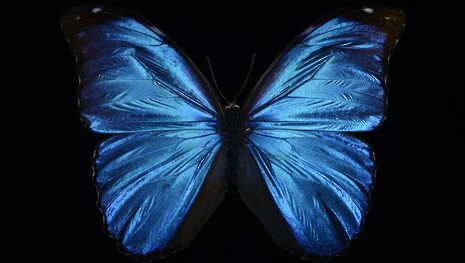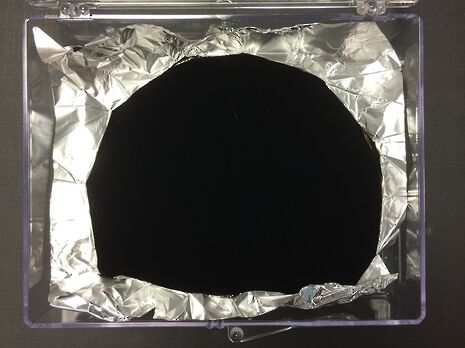The power of the colour black
In her column on the secret life of colour, Olimpia Onelli discusses the colour black, from prehistoric uses to its role in modern nanotechnology

Though crucial to our everyday life, colour is actually an artefact of our perception of visible light reflection. Our eyes perceive colours spanning from violet to red due to the three types of receptor cells, ‘cones’, responsible for decoding blue, green, and red wavelengths. If an object does not reflect any of these visible wavelengths, it will appear black.
However, some living organisms have four colour receptors and can therefore see more colours, a phenomenon known as tetrachromaticism. Most tetrachromatic birds are able to see ultraviolet radiation, which completely eludes our sight. As such, an object that appears black to us might actually be very colourful for a bird.
Complete absorption of visible light is usually achieved using pigments, molecules that are able to absorb light energy by transferring it to their molecular bonds. They tend to be very colour-specific (that is, they only absorb one colour) but some can absorb a broader spectral range.
The Inuit of Alaska painted masks and wooden objects using seal blood mixed with charcoal powder
Melanin, one of the most common black pigments found in nature is found in a great number of organisms – including human skin. However, it is not completely absorbing: in fact, it is more efficient at absorbing ultraviolet and blue radiation than red. For this reason, melanin plays a crucial role in protecting our skin from UV radiation damage by absorbing it before it can do any damage.
Historically, humans have tried to achieve ‘perfect’ black pigments for artistic and aesthetic applications using soot. The first known use was by Neolithic man to draw the contours typical of cave art. Aqueous black inks date to the 23rd century BC when the Chinese started using plant dyes and graphite powder combined with water to obtain a material which could be applied with a brush.

Similar tricks were used by the Romans and later by artists throughout the Renaissance. The Inuit of Alaska painted masks and wooden objects using seal blood mixed with charcoal powder. Only in the mid-19th century did the first synthetic dyes started to become available, though mostly petroleum based.
As pigments often bleach over time due to the degradation of their molecular structure, searching for another route of colour creation has become key. Recently, scientists have begun to work on a different approach: creating nanostructures capable of “guiding” light to complete absorption instead of relying on the molecular structure and chemistry of the material. This is inspired by natural structures seen in butterfly wings. With a disordered array of nanoholes, some species may absorb light efficiently which is beneficial for their thermoregulation. Researchers at KIT Germany have used these same principles to produce material that can absorb light so as to enhance the efficiency of solar panels (with more absorbed light conferring more energy produced).
Synthetically, Vantablack, the blackest material in the world was tested by the National Physical Laboratory in the UK. It is comprised of a periodic array of carbon nanotubes (hence the name, “Vertically Aligned NanoTube Arrays”). Inspired by the butterflies, the tubes are able to “guide” light that is eventually absorbed and converted into heat. Vantablack has quickly become a commercial product with its very high absorbance (over 99%) over the whole of the visible light spectrum.
However, it may only be grown at very high temperatures (circa 400°C), making it difficult to use it on less thermostable substrates. With scientists and private companies working on improving the fabrication process, there are sure to be vast advancements with this colour technology in the future.
 News / SU reluctantly registers controversial women’s soc18 December 2025
News / SU reluctantly registers controversial women’s soc18 December 2025 News / CUP announces funding scheme for under-represented academics19 December 2025
News / CUP announces funding scheme for under-represented academics19 December 2025 Features / Should I stay or should I go? Cambridge students and alumni reflect on how their memories stay with them15 December 2025
Features / Should I stay or should I go? Cambridge students and alumni reflect on how their memories stay with them15 December 2025 Fashion / The art of the formal outfit 18 December 2025
Fashion / The art of the formal outfit 18 December 2025 News / Dons warn PM about Vet School closure16 December 2025
News / Dons warn PM about Vet School closure16 December 2025










